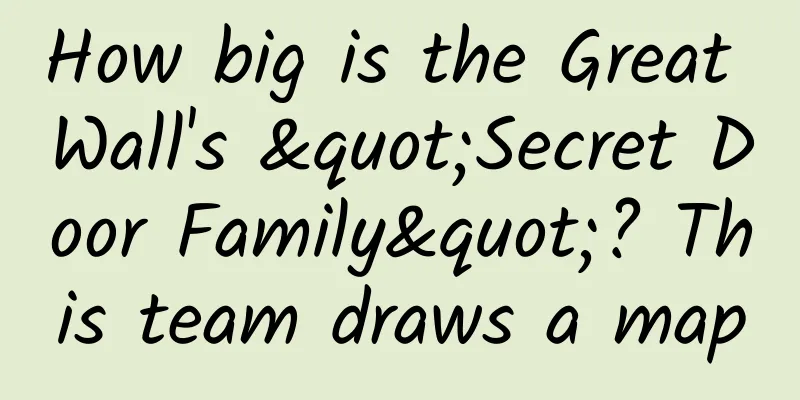How big is the Great Wall's "Secret Door Family"? This team draws a map

|
Over the past two thousand years, the Great Wall has evolved from an agricultural and pastoral economic barrier into a cultural bloodline that carries history. Located in a place where few people go, after years of erosion and natural weathering, this historical miracle has gradually been stained with traces of time, and the secrets hidden in it are gradually disappearing. (Copyrighted image from the gallery, no permission to reprint) The research team used the latest technology to survey and map the Great Wall in order to obtain accurate data and digitally restore the Great Wall. "We fly 'planes' and ride 'tanks', following clues from ancient books to explore the mysteries of the Great Wall." Not long ago, at the Tianjin University Great Wall Research and Digital Achievement Exhibition held at the Tianjin Museum, Li Zhe, a researcher at the School of Architecture of Tianjin University, said with emotion. Behind Li Zhe, thousands of years of history and modern technology converge at this moment. Since 2003, Li Zhe's team led by Professor Zhang Yukun of the School of Architecture at Tianjin University has been connected with the Great Wall. In 2010, the team launched the "Ming Great Wall Defense System Spatiotemporal Database" project, and at the end of 2018, the team launched the "Great Wall Entire Line Real Scene 3D Image Collection" project. Over the past four years, the team has conducted digital mapping of the entire Ming Great Wall across 10 provinces and regions, collected more than 2 million real-life photos, and established a "3D real-life database of the entire Great Wall", which currently covers 90% of the artificial wall sections and has expanded to relics from multiple dynasties including the Han, Northern Dynasties, Tang, Song, and Qing dynasties. 1 Drone mapping easily collects massive real-life images of the Great Wall "Do you see this inconspicuous hole in the Great Wall? With the naked eye, it may seem like a damage that is easy to overlook." Li Zhe pointed to the photo and said to the Science and Technology Daily reporter, "Based on the real-life 3D database of the entire Great Wall, with the help of AI technology, we discovered these suspicious images and re-investigated the site. We can then identify that this is a secret door in the Great Wall." Most new discoveries are based on the mastery of three-dimensional images of the entire Great Wall, and the shooting of massive real-life photos is the foundation of the foundation. Previously, the State Administration of Cultural Heritage had worked with the National Bureau of Surveying and Mapping and other units to conduct a survey of the Great Wall resources, and had collected complete information on the length, coordinates, age, and basic preservation status of the Great Wall. However, there was a lack of information on the details and facilities of the Great Wall, such as the distribution of the entire line of the Great Wall's diseases, the detailed structure, facilities, and decoration of the Great Wall, etc. The project of collecting real-life 3D images of the entire line of the Great Wall is to make up for this missing link. Li Zhe believes that this work cannot be done blindly by only looking at the details, and a comprehensive understanding cannot be done by sketching in broad strokes, but requires detailed accounting. "Detailed accounting requires fine data granularity, that is, the resolution of the collected photos must be fine enough to see every brick seam, and at the same time they must be continuous from multiple angles." Li Zhe said that previous resource surveys only obtained an average of 8 representative photos per kilometer, while this project requires the collection of about 300 photos per kilometer at uniform distances and from multiple angles. The Great Wall winds for thousands of kilometers, mostly in remote areas, and is located in steep and rugged places. It is difficult to photograph all sides of the Great Wall using high-altitude remote sensing mapping methods such as satellites and manned aircraft. And because the wall is distorted in three-dimensional space, observers cannot judge the overall layout if they are in it. "It's impossible to take complete photos from a high altitude, and sometimes there's no place to step when shooting from the ground." Li Zhe introduced that the team began to apply drone low-altitude information collection technology in 2004. The drone surveying and mapping's precise following and scanning operations as well as its multifunctional ability to complete a variety of data collection have made it the most efficient data collection method for this project. **Drones can follow the winding walls to conduct detailed exploration of the sides, tops, and even the interiors of enemy towers of the Great Wall. **As a carrier, drones can also carry different sensors to transform into surveying and mapping equipment with different functions. "Drones + ordinary cameras" can be used for photography and aerial surveys; "Drones + infrared cameras" can be used to image the thermal radiation of the Great Wall, thereby exploring some of the internal structures or hidden facilities of the Great Wall; "Drones + LiDAR" can use lasers to scan the remains under the trees from the air, and then use technical means to "peel off" the data of the trees, so that the image of the Great Wall hidden under the trees can be clearly seen. With the help of drone mapping, data collection has been greatly enhanced, and team member Li Yan has a deep understanding of this. "The city came first and then the wall. Town cities, road cities, acropolis cities, fort cities and fort cities are also important parts of the Great Wall defense system." Li Yan, who is responsible for the measurement of this part of the city, told reporters that the circumference was initially measured by walking and measuring with a tape measure, which was not only slow, but also useless when encountering a wall built on a hillside between two hills. Using traditional surveying and mapping methods, at most two cities can be measured in a day, while drone mapping only takes 10 minutes to fly a circle, and the data of the entire city can be collected completely. However, the use of new measurement methods often brings many problems. The most important thing to pay attention to in this process is the different environmental issues. From the ambient temperature and humidity to the battery, they will affect the safety of the operation and are factors that need to be considered in the measurement. "In fact, it is not only about collecting three-dimensional data. From the very beginning of the measurement, we have to explore how to optimize the drone measurement route under extremely undesirable conditions (such as various obstructions)," said Li Zhe. Therefore, before each measurement, the team will discuss in detail whether there are interfering obstacles in the terrain, safety measures to deal with interference during the shooting process, the best route during the shooting process, etc. It is precisely this time and again of continuous improvement that has brought us today's wide-ranging, continuous, and detailed 3D data. 2 3D modeling technology brings the Great Wall into the museum The team spent more than four years to complete the image collection for the photogrammetry of the Great Wall of about 5,500 kilometers, and established a continuous image library consisting of more than 2 million real-life photos of the Great Wall. The Ming Great Wall is the main trunk and accounts for the vast majority, and it also spreads to the more scattered remains of the flint in the Qing Dynasty, as well as the Great Wall built by the Tang, Northern Wei, Eastern Wei and Han dynasties. The overall range covers from the west of Shenyang to the east of Korla. (Photo source: Tianjin Museum official Weibo) "The coordinates of each photo are presented in a library under a WebGIS (web geographic information system) environment, enabling free browsing of the Great Wall." Li Zhe pointed to the screen and said, this is the Jinshanling Great Wall, which can be enlarged to a centimeter-level clarity, and every gray seam can be seen clearly. No country in the world has such a continuous Great Wall image library. Making good use of these precious and massive real-life photo data is a process of constantly discovering value. Li Zhe admitted that he was a little confused in the initial stage of the Great Wall surveying and mapping. Initially, he just wanted to take multi-angle photos that could fully cover the Great Wall and have a large amount of detailed Great Wall image resources. "It is crucial to digitize and archive the entire Great Wall, but as I delve deeper into the research, I realize that the Great Wall is a valuable cultural heritage of the Chinese people and even of all mankind," said Li Zhe. "We need to use our expertise to supplement the architectural interpretation of the Great Wall and combine it with the results of archaeology to gain a more comprehensive understanding of the Great Wall." Based on the architectural structure knowledge of the architecture major, the real-scene three-dimensional model obtained by low-altitude photogrammetry of drones can be edited, processed and quantitatively analyzed, and then applied to disease analysis, scene restoration and other tasks. "The real-life 3D model itself is very valuable. Statistics on the slope, size measurement, and disease conditions of the Great Wall all rely on the 3D model, so it has a wide range of uses." Li Zhe gave an example, such as counting the locations of known collapse incidents of the Great Wall in recent years, and then combining it with the 3D model to discover the pattern of collapse: all collapses occurred at the turning point from the steep section of the mountain to the flat section. In this way, the cause of the disease can be revealed from the law of the phenomenon. In addition, the missing structures can be artificially constructed based on the real-life 3D model. Many hollow wooden towers only have four outer walls left. Artificial modeling can be used to complete the internal wooden beam and column structure, and restore the entire hollow tower from the inside out. The artificial modeling process generates videos or animations through rendering, making the Great Wall, which has been eroded by time, "live" again with vitality. (Photo source: Tianjin Museum official Weibo) **These three-dimensional models can also be made into models through 3D printing technology, so that the real scene of the Great Wall can be "moved" to the museum vividly. **This exhibition displays a large number of 3D models of the Great Wall, and the explanations allow viewers to see it clearly at a glance. Li Yan pointed to a small hole on the 3D printed model of the Tang Dynasty garrison and said to the reporter: "This is the smoke duct for cooking in the past. The physical model in the museum perfectly reproduces the current state of preservation of cultural relics." 3 AI helps sort out the secret and great "family tree" of the Great Wall The "secret passage" of the Great Wall has emerged from history books into reality. Over a period of more than four years and across 10 provinces and regions, the research team took continuous photos of more than 90% of the artificial walls along the entire Ming Great Wall with a resolution close to centimeters. They identified more than 130 secret doors and constructed their "family tree" for the first time. "The Great Wall is not just 'a wall'." Zhang Yukun, head of the research team, expert on the Great Wall defense system and professor at the School of Architecture of Tianjin University, introduced that the Great Wall defense system includes multiple subsystems such as town cities, road cities, citadels, garrison cities, fort cities, post cities, beacon towers, military farming systems, passes, enemy towers, and walls. Li Zhe believes that one of the core significances of **the Great Wall surveying and mapping is to point out to the public that the Great Wall is a system, **and its overall distribution is similar to a radial shape, which the ancients described as "dragons flying and phoenixes soaring." Due to technical limitations, Great Wall’s huge “family” has never been systematically sorted out. The establishment of a real-life three-dimensional database of the entire Great Wall and the auxiliary application of artificial intelligence have made this massive and systematic sorting work possible. "It is obviously unrealistic for humans to look through more than 2 million photos one by one, so artificial intelligence can help with the screening." Zhang Mengdi, a doctoral student in the team who is responsible for database programming and artificial intelligence image screening, gave an example. For example, if the team wants to sort out hollow enemy towers, they can find photos to train the computer to understand the various characteristics of hollow enemy towers. After obtaining a mature model algorithm, the machine can quickly identify all hollow enemy towers in a large number of photos. For hollow enemy towers, the current AI recognition accuracy has reached 90%. Among the many "family trees" of the Great Wall, the secret door is a "secret and great" system that exists in the Great Wall. Li Zhe pointed to a replica of a map drawn during the reign of Emperor Qianlong of the Qing Dynasty on the wall and told the Science and Technology Daily reporter that this map was discovered by Li Yan when he was studying abroad. The Great Wall on it is clearly visible, and military facilities such as secret doors are also marked. Secret doors are short doorways that are opened in hidden sections of the Great Wall according to terrain, military needs, and other requirements, and are secret entrances and exits facing the outside of the Great Wall. "The secret doors hide the secrets of the Great Wall and the wisdom of the ancients." Li Zhe said that such research was rare in the past. Through manual screening combined with AI search, researchers found more than 130 physical remains of secret doors. They not only analyzed the pictures, but also conducted field investigations on some of them, and found that each secret door was highly consistent with the local terrain, and its structure varied according to needs. "I have to admire the design of the ancients. The setting of secret doors is very flexible. For example, the turning secret door can ensure that in scenes like the horse market, the secret door can block the horses and protect the people on the other side from being hit by the horses." Li Zhe said. Of all the secret doors discovered, the most exciting discovery for the team was the sudden door. "Moreover, a gate should be dug secretly in the city wall at a place where soldiers can enter and exit conveniently, leaving more than a foot of space outside so as to prepare for sending out troops to attack the enemy." As early as the Spring and Autumn Period and the Warring States Period, a special article on the Tumen was written in the chapter "Preparing for the Tumen" in "Mozi". Scholars in the Tang, Song, Ming and Qing dynasties all recorded the Tumen, but no corresponding physical evidence had been found before. **"The secret passage is set up to implement surprise attack tactics. **Wei Yuan, a famous scholar in the late Qing Dynasty, once used the phrase 'hiding under the nine earths is called concealed, and moving above the nine heavens is called surprise' to describe the secret passage." Zhang Yukun explained that a layer of bricks was laid outside the secret passage to serve as a camouflage. During a surprise attack, the soldiers could break through the wall by breaking through the thin brick wall and catch the enemy off guard. Through the photos, the team members found a hole-like relic on a wall after it was broken. The hole was in an uneven state, rather than a regular structure designed and built in advance like an ordinary secret door. "We were not sure whether it was a protruding door or a broken one. After field investigation, we collected real-life photos of the inside and outside of the hole. After 3D modeling, we unified the inside and outside into one model and finally determined that it was a protruding door." Li Zhe said with emotion that the discovery of the protruding door and the sorting out of the secret door family are inseparable from the "3D database of real scenes of the entire Great Wall". So far, the team has confirmed a total of no less than 220 secret doors in combination with ancient maps, and discovered more than 130 physical remains. They also found a clear record in the official historical materials of the Ming Dynasty that "according to the system of our ancestors, many secret doors were left under the border walls." This has confirmed the existence of secret doors under the passes and entrances, a third-level customs clearance facility, with both physical and documentary evidence. Currently, the team is conducting a comprehensive review of the subsystems of the Great Wall defense system, including forts, cities, beacon lines, post lines, trade facilities, and edge walls. Produced by Science and Technology Daily and Deep Eyes Studio ◎ Interview and writing: Science and Technology Daily reporter Chen Xi ◎ Planning丨Zhao Yingshu, Teng Jipu, Lin Lijun |
>>: Dreamy and beautiful! Spacecraft travels in space, touching your heart instantly
Recommend
Download the txt version of Cold Reading, download the pdf version of Cold Reading from Baidu Netdisk
Cold Reading Book List Introduction Introduction ...
How to write the copy for May 1st Labor Day?
It’s not Labor Day yet. The chat mode of " w...
What is the difference between a chief content officer and a chief marketing officer?
Jay Chou signed a contract with Vipshop and becam...
Facebook dominates mobile! Daily active users reach 800 million
[[132525]] As Internet users around the world swi...
A strange transient was discovered, ejecting 10% of the mass of the sun at a speed exceeding 55% of the speed of light
Astronomers have discovered a new astronomical tr...
Ideas + steps + methods, three steps to teach you how to quickly build user portraits?
If you are walking on the street and see a person...
How is live broadcast from space achieved? What builds space WIFI?
On July 6, 2021, my country successfully launched...
Along with "Black Goku", another trending topic is a research conclusion that "video games are good for health"?
In mid-to-late August, Black Myth: Wukong, the fi...
Can the sun generate electricity? The sun can generate electricity!
The progress and development of society cannot be...
If there is no growth, why don’t you try Zhihu? Zhihu Follower Increase Secrets
Traffic is something that all major companies are...
How's the battery life on the new iPhone 6? Disappointing
The iPhone 6 and iPhone 6 Plus have bigger, brigh...
What is the difference between confirmed and asymptomatic infection?
Mixed Knowledge Specially designed to cure confus...
Be careful of burns when using a warm baby in winter
Every cold winter Human beings are all related to...
How to successfully implement mobile device management
Thanks to increased operating system capabilities...
Inspired by bats, a new scanning technology has been developed that can detect whether underground pipes are leaking!
Engineers have developed a new scanning technolog...









